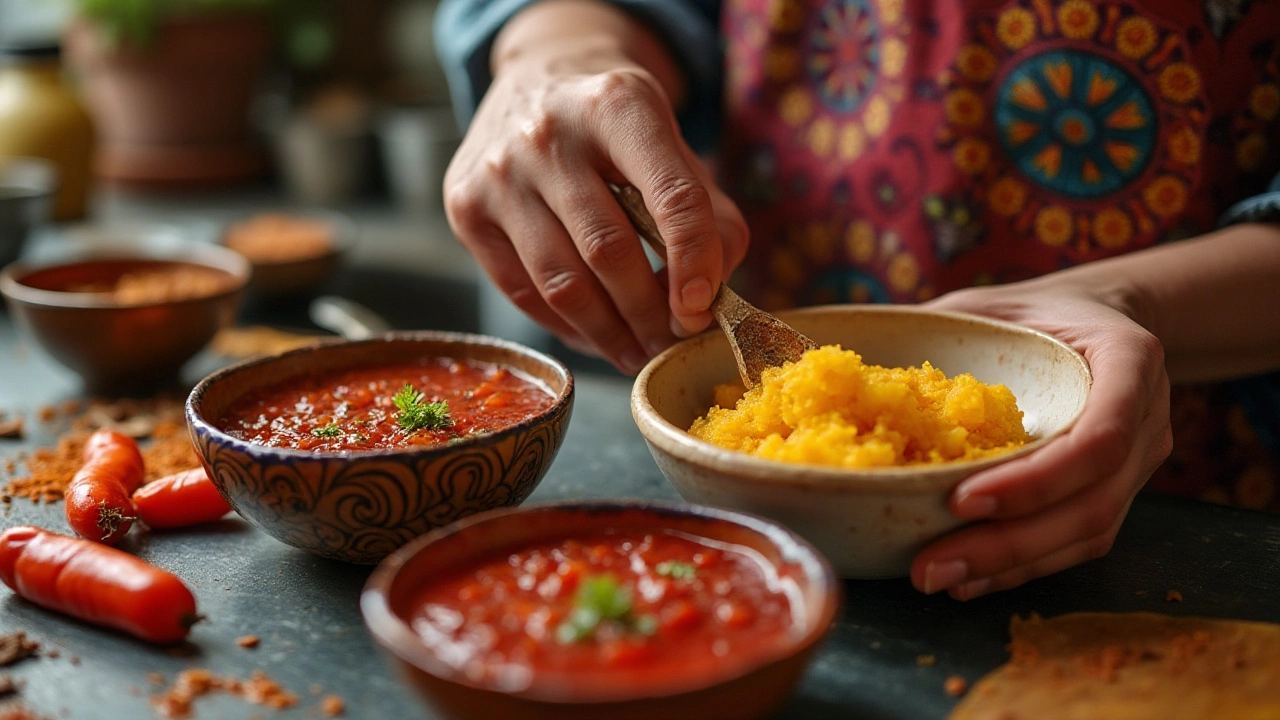24 Nov 2024
- 0 Comments
In the world of flavors, the discussion around red onion marmalade and chutney often sparks curiosity among food enthusiasts. These two condiments, while sharing certain characteristics, hold their own distinct places in culinary traditions. Both are beloved for their ability to elevate a simple meal with a burst of taste.
Red onion marmalade, with its deep, sweet, and tangy notes, serves as a perfect companion to cheeses and meats. On the other hand, chutney, which hails from the Indian subcontinent, showcases an exciting blend of spices, sweetness, and sometimes heat, making it a delicious addition to various dishes.
Though they might seem similar at a glance, understanding their unique qualities will allow you to create or choose the right accompaniment for your culinary creations. Let us explore what makes each of these condiments special, how they differ, and how you can thoughtfully incorporate them into your meal planning.
- Defining Red Onion Marmalade
- Understanding Chutney
- Key Differences and Similarities
- Culinary Uses and Pairings
Defining Red Onion Marmalade
Red onion marmalade is a delightful and deeply flavored condiment that has found its way into the hearts and kitchens of food lovers around the world. This marmalade is known for its sticky, sweet yet savory profile, making it an irresistible addition to a wide range of dishes.
At its core, red onion marmalade begins with the humble red onion. Known for their vibrant color and subtle sweetness, red onions become the star of this condiment once cooked down slowly with sugar and vinegar. The transformation process involves caramelizing the onions until they achieve a glistening, sticky consistency. This method brings out an incredible depth of flavor, balancing the sweetness of the sugar with the tang of vinegar. Sometimes, ingredients like red wine or balsamic vinegar are used to enhance and add complexity to the taste.
The preparation of red onion marmalade is an exercise in patience and careful seasoning. As the onions cook, the sugars break down, creating a luscious, almost jam-like texture. The resulting marmalade is not only visually appealing, with its rich, deep maroon hue but also a culinary delight. It pairs exceptionally well with a variety of foods. Often served alongside cheese platters, it cuts through the richness of cheese, providing a tangy counterpoint.
Some recipes also incorporate herbs such as thyme or rosemary, adding an aromatic dimension that complements the sweetness of the onions. Other variations might include a hint of chili for those who enjoy a kick of heat, showcasing the versatility of this condiment.
Joy Neerhen, a reputed culinary author, once wrote, "A well-made red onion marmalade is like a symphony of flavor; it transcends the ordinary to elevate simple dishes to gourmet status."
Red onion marmalade is celebrated not only for its taste but also for its role in sustainability within home kitchens. Traditionally, it serves as an excellent method to make use of an abundant harvest of red onions, contributing to reduced food waste. It's no wonder that this condiment has earned a cherished place in many households, appreciated for its flavor and practicality.
While red onion marmalade can be enjoyed immediately after preparation, its flavor improves with time. Storing it in a cool, dark place allows the tastes to mature, developing even more complexity and richness. Because of its long shelf-life, it can be made in larger batches and kept ready for any occasion, making it both a convenient and sophisticated choice for home cooks. Whether you're hosting an elaborate dinner or crafting a simple sandwich, incorporating this marmalade offers a touch of elegance and a punch of flavor that surely makes it worthwhile to master this delightful condiment.

Understanding Chutney
When one thinks of chutney, a colorful mosaic of flavors, textures, and traditions comes to mind. Originating from the Indian subcontinent, chutney is a vibrant concoction that has delighted palates across the globe for centuries. It is a versatile condiment that exists in myriad forms, often categorized into two main types: fresh and cooked. Fresh chutneys are typically made with a blend of uncooked ingredients, such as cilantro, mint, coconut, or various fruits, combined with spices to create a refreshing and zesty accompaniment. Cooked chutneys, on the other hand, involve a process of simmering fruits or vegetables with spices, vinegar, and sugar, resulting in a rich and tangy preserve.
The ingredients used in chutneys can vary tremendously, reflecting the diverse culture and landscape from which they come. Popular choices include mango, tamarind, apple, and tomato, each carrying its own unique flavor profile. Historically, chutneys were made from surplus fruits and vegetables, allowing households to preserve the bounty of harvest and enjoy seasonal flavors throughout the year. This not only highlights the cleverness of chutney as a culinary invention but also its role in food preservation. According to celebrated cookbook author Madhur Jaffrey, "Chutneys are an integral part of Indian cuisine, a reflection of the culture's dynamic and vibrant nature."
"Chutneys are not mere accompaniments but rather a celebration of the bold and the beautiful in a jar," Jaffrey notes, underscoring their artisanal quality.
In the modern culinary world, chutneys have broken boundaries, being used not only in Indian dishes but also as a complement to cheese platters, grilled meats, and even in sandwiches. Chefs around the world have embraced its complex flavors, introducing chutney into fusion cuisines and innovative recipes. A quintessential example is the use of sweet mango chutney paired with savory British dishes, a testament to the versatility and global appeal of this condiment. Whether you are exploring a spicy chili chutney with a punchy kick or a fragrant ginger and pear chutney, each jar promises a journey through layers of taste and texture, offering something new at every bite. With each spoonful, the world of chutney invites you to embrace the magic of spice and sweetness, crafting a perfect balance that is both exotic and familiar.

Key Differences and Similarities
When exploring the nuances between red onion marmalade and chutney, it's easy to see why these condiments often elicit debates even among seasoned food connoisseurs. Both share a fundamental essence of being sweet and savory accompaniments, yet they spring from different culinary traditions, carrying distinctive profiles that cater to diverse taste palates. Red onion marmalade, often simmered with red wine and balsamic vinegar, has a rich, caramelized texture that envelopes the tongue with a complexity of flavors. Its subtle sweetness balanced by a gentle tang makes it a revelation when paired with roast beef or an artisanal cheese platter. In contrast, chutney boasts a more varied personality. Originating from the Indian subcontinent, chutney is not only a sweet condiment but may also be spicy or tangy, made with a myriad of ingredients including fruits, vegetables, and an array of spices.
The preparation of these two distinctive condiments further underscores their differences. While both can be time-intensive, red onion marmalade is typically a long, slow reduction of its ingredients until they meld into a luscious jam-like consistency. This process allows the onions to shed their pungency in favor of a note-rich sweetness. On the other hand, chutney can be a raw blend of finely chopped ingredients quickly mixed to brighten a dish, or a slow-cooked concoction that deepens its flavors over time. It is this versatility in preparation that garners chutney its global appeal. A key difference is the spice component; many chutneys incorporate a variety of spices such as cumin, coriander, and sometimes even chilies, which gives them a distinct spicy kick that red onion marmalade lacks.
Yet, despite these differences, one cannot overlook the similarities that bind these two condiments. Both aim to complement rather than overpower the main dish. They are crafted to strike a balance of flavors, enhancing the overall eating experience. Historically, both have served as methods for preserving surplus produce, thereby cleverly extending the bounty of a harvest season across months. It is interesting to note how these condiments are prepared with similar preservation intentions despite their vastly distant geographies and cultural origins. As food historian Holly Haines notes, "The evolution of these condiments is a testament to how culinary traditions can intertwine and diverge, creating distinct yet familiar flavors that enrich our tables."
In their application, both red onion marmalade and chutney are incredibly versatile, often finding perfect harmony with cheese, charcuterie, and roasted dishes. Modern culinary practices have seen them extend beyond traditional pairings to become dynamic additions in gourmet burgers, toasted sandwiches, and even as a spread for an avant-garde twist on classic pizzas. It is their shared purpose of enhancing the base flavors of a dish that brings them into this interesting dialogue of comparison. Yet, knowing when to choose red onion marmalade over chutney—or vice versa—can elevate a dish from ordinary to extraordinary, reminding us that in the world of culinary arts, understanding and appreciating unique profiles is what truly makes an unforgettable dining experience.

Culinary Uses and Pairings
When it comes to enhancing your dishes with exciting flavors, red onion marmalade and chutney offer a delightful spectrum of culinary possibilities. Each of these condiments brings its unique character to the table, ensuring that every bite is packed with nuanced flavors and aromas. Let's first look at red onion marmalade, a versatile ingredient known for its sweet and savory profile. This marmalade is a wonderful addition to any cheese platter, where its rich sweetness perfectly complements the sharpness and creaminess of various cheeses. Whether you're serving a robust cheddar or a creamy brie, this marmalade is sure to become a favorite pairing.
Chutney, with its origins in the Indian subcontinent, adds an exotic touch to your culinary adventures. This condiment is as diverse as its many regional variations, each bringing a new dimension of flavors to whatever it accompanies. Chutneys can vary widely, from sweet mango chutneys to spicier versions featuring ingredients like tamarind or chilies, making them a versatile choice in the kitchen. They’re often served alongside curries or samosas, but don't be hesitant to explore beyond their traditional pairings. In an interview, celebrated chef Madhur Jaffrey remarked,
"Chutney is imagination unleashed, a concoction which can be as simple or as complex as you wish."
When creating meals, consider using these condiments to elevate the simplest dishes. Imagine spreading a layer of red onion marmalade on a sandwich. Its flavor brings a sophisticated sweetness that contrasts beautifully with roasted meats or grilled vegetables. For vegetarian dishes, a dollop of chutney can add intrigue and flavor depth. Try stirring some into a pot of lentil soup, or using it as a glaze for roasted tofu to impart rich, sweet, and spicy flavors.
Combining these condiments with proteins is another delightful approach. While red onion marmalade excellently pairs with grilled steak or roasted chicken, chutney can transform your pork chop dinner with a spicy and sweet kick. Consider trying a new twist on the classic griddle-pan salmon by adding chutney for an unexpected flavor explosion. To maximize flavor complements and contrasts, here's a quick guide:
- Cheese Board: Red onion marmalade with aged cheddar
- Roasted Proteins: Red onion marmalade with beef; spicy chutney with chicken
- Grilled Sandwiches: Both red onion marmalade and chutney with turkey or ham
- Vegetarian Dishes: Chutney stirred into lentil soups or as tofu glaze
So, while red onion marmalade and chutney might initially seem like simple condiments, their uses and pairings extend far and wide. They invite creativity and innovation into the kitchen, inspiring both novice and seasoned cooks to venture beyond standard flavors. The next time you're planning a meal, think about how these condiments might add a unique twist to your dishes.
